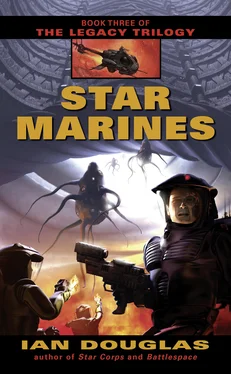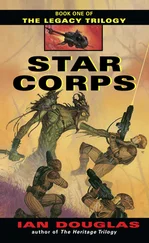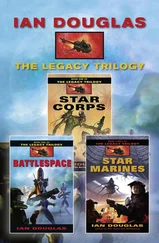And, of course, Brigadier General Clinton Vincent Garroway, CO of 1MIEU. Strictly speaking, the IMAC test didn’t directly concern his command, but there was no way he wasn’t going to be present, not with his nephew riding one of those hot tin cans down from orbit. Keeping him clear of the Phobos observation deck would have required a direct order from the Commandant … backed up by nothing less than the battlecruisers and carrier squadrons of Fifth Fleet.
Sometimes it seemed tougher watching from the rear. …
“When will we be able to get direct data again?” Hudson asked over the noumenal link. “I don’t like being in the dark up this way.”
“According to the predicted track … another thirty seconds or so,” Jollet told him. “Then we’ll have all the data we can slurp.”
“Assuming they make it through,” Hudson said.
“Don’t even think it, Walter,” Garroway growled over the link. “ They’ll make it! ”
“I just don’t like this reliance on alien technology,” Hudson said. “We should have developed it on our own.”
“Beggars,” Jollett told him, “can’t be choosers.”
“Well, it does look like everything’s going smoothly,” Hudson said.
“I imagine the Marines sealed inside those cans would have something to say about that,” Lee replied, wryly amused. “According to the predicted flight track data, they’re at the point of maximum turbulence in their descent. I imagine things are a bit wild, right now.”
“Roger that,” General Garroway added. “Damn, I wish I was down there with them!”
“They can handle it, General,” Admiral Jollett said.
“Damn right they can handle it, Admiral. They’re Marines . ”
Lee felt the pride in the older man’s mental voice, but couldn’t detect any fear. He knew the general was close to his nephew; he honestly didn’t know how the man was handling the stress of … just watching, watching as his nephew fireballed into atmosphere at five klicks per second.
Like General Garroway, Lee’s single biggest regret was that his request to accompany the team had been unceremoniously rejected. He was a firm believer in leading from the front.
Assault Detachment Alpha
Above Olympus Mons,
Mars
1236 hrs, local
His noumenal HUD showed him the probable locations of each of the other fifteen IMACs in Alpha Section. Probable location meant just that. For the duration of the communications blackout incurred during re-entry, transponder signals were scrambled and the datalink connecting the Marines with one another and with headquarters wasn’t much more than wishful thinking. His battlesuit’s AI was taking an educated guess on the current positions of the other IMACs, based on the last recorded vector of each, and plotting them on the display imagery unfolding within his mind.
Directly below, the caldera of Olympus Mons opened like a gaping mouth—an oval eighty-five kilometers long, sixty wide, and a sheer-sided three kilometers deep. Six overlapping pit craters pocked the yawning caldera; he could see a trace of snow in the shadows. The atmospheric pressure there was too low to permit water vapor to freeze out; those white streaks must be frozen carbon dioxide.
And then the mountain was falling away behind him, the vast swelling of the mountain dropping faster than the IMAC’s descent. At his mental request, data cascaded through his noumen. Altitude now thirty-two kilometers, dropping at three hundred meters per second, velocity four point one kilometers per second. A bubble of superheated plasma was forming around him—not thick enough yet to block visibility, but fiery enough to create the illusion of blowtorch flames billowing past him.
His heart was pounding, his mouth dry. He felt like he was getting hotter, and sternly told himself it was his overactive imagination. He’d worked with IMACs endlessly in simulation, both on Earth, and ever since he’d arrived at the Marine Corps Deep Space Training Facility at Eos Chasma. But this was his first time in one for real, his first time stuffed into a shit-can and fired out of a Marine Stealth Starfire in planetary orbit.
Another thud, a hard one, and his AI feed reported chunks of ablative falling away. From his vantage point, it looked as though he’d just loosed a salvo of flares through the fireball. He had to remind himself that that was what was supposed to happen. As the ceramic ablative material broke free of the IMAC, it helped shed some of the fierce heat building up outside, scant centimeters from his battle-armored body, and also added to the confusion of ground-based sensors and AIs.
But it was difficult to avoid the disconcerting thought that he was flying in a conventional spacecraft, and that pieces were breaking off and falling away.
Altitude twenty-five thousand meters, a voice told him in his mind. Deploy air brakes and aeroform surfaces, yes, no?
“Negative on air brakes and aeroform,” he told the AI in his head. “We’ll deploy at twelve thousand meters, with HALO deployment as automated backup.”
In other words, if something nasty happened and he was rendered unconscious or worse by high G-forces in the next few moments, the AI would still bring him safely to the surface. Or what was left of him, at any rate. The important thing was that the data from his suit be retrieved.
Very well. Backup HALO deployment confirmed. I will reconfirm at seven thousand meters.
“Nag,” he told it. There was no response. The suit AI was rather limited in its conversational abilities, or, indeed, for any thought beyond an extremely narrow purview.
Ahead, he could see three more shield volcanoes stretched across the horizon in orderly procession. Similar to Olympus Mons, but far smaller, they were, with their huge cousin, part of the ancient Tharsus Bulge, a static region of volcanic activity where magma deep beneath the planet’s surface crust had upwelled into the crust perhaps a billion years ago. From north to south they were Ascraeus Mons, Pavonis Mons, and Arsai Mons. The central mountain, he recalled, was perched almost precisely on the Martian equator. His descent would carry him above Ascraeus Mons, on the left.
Garroway gave his flight system indicators another mental glance. Everything was tracking as expected. Decoys maintained their position in a loose cloud around and ahead of him, each leaving its own meteor-trail of ionized gas.
Ascraeus Mons slid gently past below, followed moments later by the vast and tangled patchwork of rills and canyons dubbed Noctis Labyrinthus, the Labyrinth of Night. Strike Force Sierra One-one burned through the dark Martian sky.
Operation Skyfire. It was a training exercise— only a training exercise, though that didn’t mean Garroway and his fellow Marines were guaranteed a ride back to base and a hot shower when they got there. Marines trained constantly, honing skills against the day when they would be needed for actual combat. Two millennia before, the Jewish writer Josephus had observed of the Roman legions that their exercises were bloodless battles, their battles bloody exercises, and that could accurately be said of the modern U.S. Marine Corps as well … except for the fact that even training exercises could turn bloody in a single unguarded instant.
Today, a total of thirty-two Marines of Bravo Company, of the 3rd MarDiv’s 2/1, were training with the newly commissioned IMAC combat-insertion pods, launched from one of the equally new S/R F-8 Starfire deep-recon spacecraft. The mission objective was to enter the Martian atmosphere and deploy in a simulated planetary surface strike. Their intended LZ was a stretch of ancient watercourse terrain at the far end of the Vallis Marineris called Eos Chasma, not far from the Eos USMC Deep Space Training Facility.
Читать дальше












